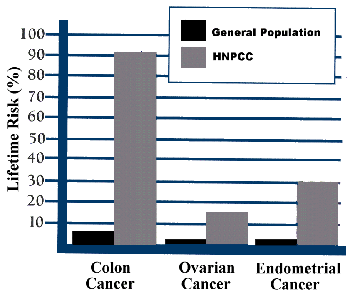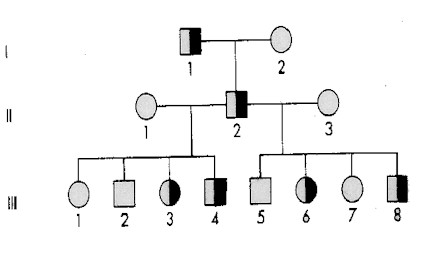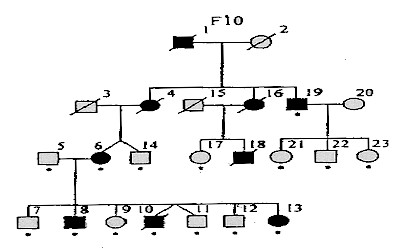6% of people with colorectal cancer have HNPCC (Ref. 6). If an individual carries one of the genes for HNPCC, his or her chances for developing colon cancer increase to 75% by the age of 75. (Ref. 4) Women who carry one of the genes also have increased risk of endometrial cancer and uterine cancer. (Ref. 4) Contrary to wide-spread myth, colon cancer occurs just as fequently in woman as it does in men.

What is the mode of inheritance for the disease?
HNPCC is inherited as an AUTOSOMAL DOMINANT disease.
(Ref. 5) This means that the disease
gene is carried on an autosome, or any one of the 22 chromosomes that are
not the sex chromosomes (X and Y chromosome). Both males and females
are equally affected by this disease. Because the disease is inherited
in a dominant fashion, only one copy of the mutant gene is necessary to
cause the disease. Each person receives two copies of every chromosome,
one from each parent. The mutant, disease gene (H) is dominant over
the normal, non-disease gene (h). The dominant H (disease) copy of
the gene overrides the recessive h (normal) copy of the gene. Thus,
h/h people appear normal and H/h people show the disease phenotype.
This means that if you get the disease gene from your mother and the normal
gene from your father, you will be H/h, and as a result, you will show
the disease phenotype.
What is a typical pedigree in which the disease has been observed?

Figure from Watson (Ref. 18) p.
512
The pedigree symbols used are as follows:
Squares = Male
Circles = Female
Horizontal lines connecting two people = Mating
Vertical lines stemming from a mating = Offspring
Shaded symbols = Affected individuals
** In this pedigree, half-shaded boxes represent
heterozygous individuals who are affected
Diagonal line through a symbol = Death
Above is an example of the inheritance pattern of any autosomal dominant disease. Affected individuals only have one copy of the disease gene (half-filled boxes). These individuals are called heterozygous because they have two different copies of the gene (one normal and one disease copy). Individuals with either both normal copies or both disease copies are called homozygous. If an affected, heterozygous individual mates with a normal individual (H/h x h/h) there is a 50% chance that each of their children will have the disease. This can be determined by realizing that the normal individual (h/h) will always pass on the normal copy, or allele, to their children. The affected parent will pass on the disease (H) allele 50% of the time and the normal (h) allele 50% of the time. Thus, each child has a 50% chance of inheriting the disease. If the affected parent had 2 copies of the disease allele (H/H), that parent will always pass on one disease allele to children. In this case, all of the children will be affected by the disease. An example of a pedigree of an HNPCC family which was used for linkage analysis is shown below. (Ref. 18)

Pedigree from family 10 (Ref. 13)
* Note: individuals 10 and 11 in this pedigree are dizygotic (two-egg)
twins
What other risk factors contribute to the occurrance of HNPCC?
Although HNPCC is an inherited disease, there are
factors that can further increase one’s risk of developing the disease.
These factors include smoking, excessive drinking, lack of exercise, and
a diet of high fat and low fiber. (Ref. 10)
Individuals who have a tendency to form benign polyps on the colon wall
are also at increased risk. (Ref. 6)
Where can additional information regarding transmission information and pedigree analysis be found?
The following sources contain more information:
|